语言学教学大纲
- 格式:doc
- 大小:192.00 KB
- 文档页数:40
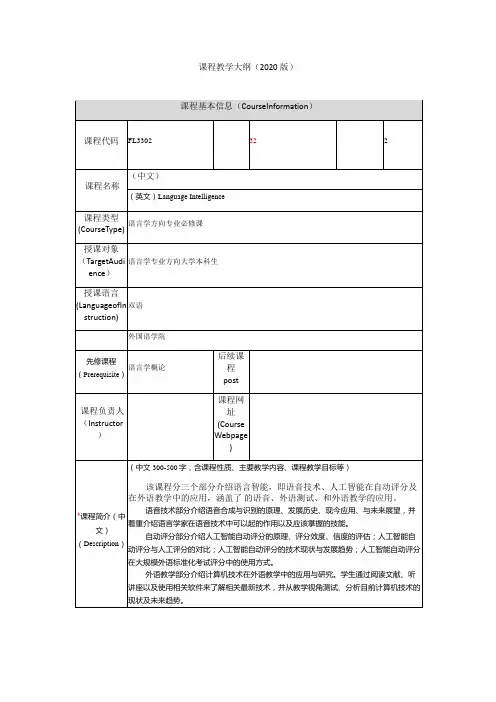
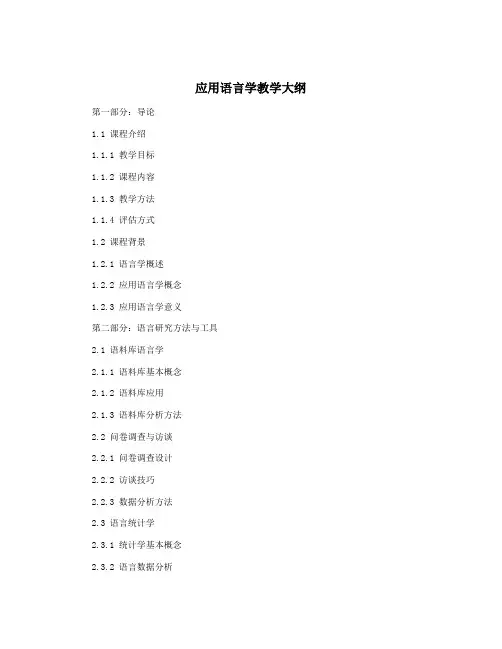
应用语言学教学大纲第一部分:导论1.1 课程介绍1.1.1 教学目标1.1.2 课程内容1.1.3 教学方法1.1.4 评估方式1.2 课程背景1.2.1 语言学概述1.2.2 应用语言学概念1.2.3 应用语言学意义第二部分:语言研究方法与工具2.1 语料库语言学2.1.1 语料库基本概念2.1.2 语料库应用2.1.3 语料库分析方法2.2 问卷调查与访谈2.2.1 问卷调查设计2.2.2 访谈技巧2.2.3 数据分析方法2.3 语言统计学2.3.1 统计学基本概念2.3.2 语言数据分析2.3.3 统计软件应用第三部分:应用语言学研究领域 3.1 语言教育3.1.1 二语习得研究3.1.2 语言教学方法3.1.3 教育语言学应用3.2 语言治疗3.2.1 言语障碍评估3.2.2 言语治疗方法3.2.3 应用语言病理学3.3 社会语言学3.3.1 语言社会地位3.3.2 语言政策研究3.3.3 方言研究第四部分:应用语言学实践4.1 学术报告4.1.1 学术报告写作4.1.2 学术论文发表4.1.3 会议演讲技巧4.2 项目设计4.2.1 研究计划编制4.2.2 数据收集方法4.2.3 项目成果呈现4.3 典型案例分析4.3.1 实际案例选择4.3.2 分析方法演示4.3.3 成果展示与讨论第五部分:综合实践与评估5.1 作业与实习5.1.1 课程作业要求5.1.2 实习安排与指导5.1.3 实践报告撰写5.2 期末考核5.2.1 考试内容与形式5.2.2 评分标准5.2.3 成绩综合评定5.3 课程总结5.3.1 教学反馈5.3.2 课程心得分享5.3.3 未来发展展望备注:大纲内容仅供参考,具体教学内容和形式可根据教学实际情况进行合理调整。
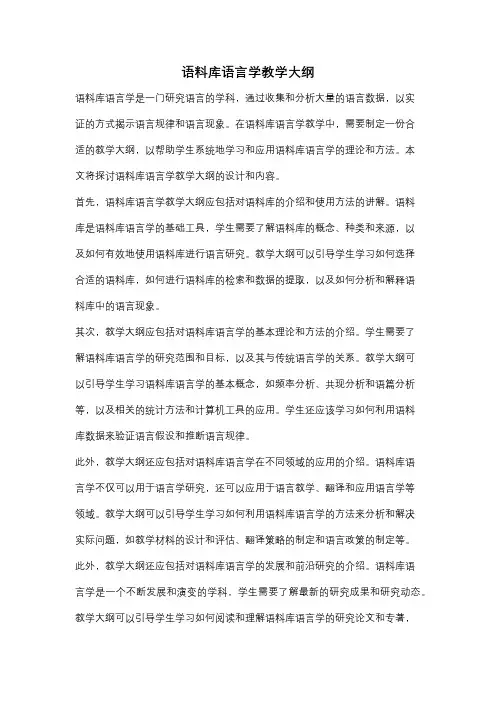
语料库语言学教学大纲语料库语言学是一门研究语言的学科,通过收集和分析大量的语言数据,以实证的方式揭示语言规律和语言现象。
在语料库语言学教学中,需要制定一份合适的教学大纲,以帮助学生系统地学习和应用语料库语言学的理论和方法。
本文将探讨语料库语言学教学大纲的设计和内容。
首先,语料库语言学教学大纲应包括对语料库的介绍和使用方法的讲解。
语料库是语料库语言学的基础工具,学生需要了解语料库的概念、种类和来源,以及如何有效地使用语料库进行语言研究。
教学大纲可以引导学生学习如何选择合适的语料库,如何进行语料库的检索和数据的提取,以及如何分析和解释语料库中的语言现象。
其次,教学大纲应包括对语料库语言学的基本理论和方法的介绍。
学生需要了解语料库语言学的研究范围和目标,以及其与传统语言学的关系。
教学大纲可以引导学生学习语料库语言学的基本概念,如频率分析、共现分析和语篇分析等,以及相关的统计方法和计算机工具的应用。
学生还应该学习如何利用语料库数据来验证语言假设和推断语言规律。
此外,教学大纲还应包括对语料库语言学在不同领域的应用的介绍。
语料库语言学不仅可以用于语言学研究,还可以应用于语言教学、翻译和应用语言学等领域。
教学大纲可以引导学生学习如何利用语料库语言学的方法来分析和解决实际问题,如教学材料的设计和评估、翻译策略的制定和语言政策的制定等。
此外,教学大纲还应包括对语料库语言学的发展和前沿研究的介绍。
语料库语言学是一个不断发展和演变的学科,学生需要了解最新的研究成果和研究动态。
教学大纲可以引导学生学习如何阅读和理解语料库语言学的研究论文和专著,以及如何参与到语料库语言学的研究中去。
最后,教学大纲还应包括对语料库语言学实践的培训和实践的安排。
学生需要通过实际操作来巩固所学的理论知识和方法。
教学大纲可以安排学生进行语料库的检索和数据的分析,以及独立完成一个语料库语言学研究项目。
通过实践,学生可以更好地理解和应用语料库语言学的理论和方法。
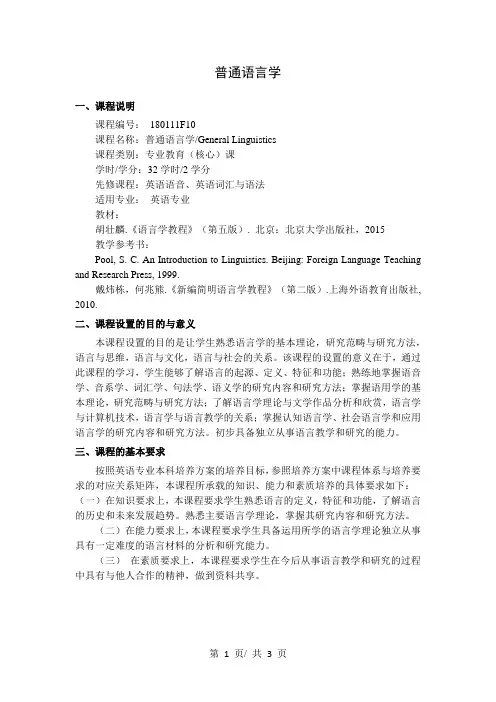
普通语言学一、课程说明课程编号:180111F10课程名称:普通语言学/General Linguistics课程类别:专业教育(核心)课学时/学分:32学时/2学分先修课程:英语语音、英语词汇与语法适用专业:英语专业教材:胡壮麟.《语言学教程》(第五版). 北京:北京大学出版社,2015教学参考书:Pool, S. C. An Introduction to Linguistics. Beijing: Foreign Language Teaching and Research Press, 1999.戴炜栋,何兆熊.《新编简明语言学教程》(第二版).上海外语教育出版社, 2010.二、课程设置的目的与意义本课程设置的目的是让学生熟悉语言学的基本理论,研究范畴与研究方法,语言与思维,语言与文化,语言与社会的关系。
该课程的设置的意义在于,通过此课程的学习,学生能够了解语言的起源、定义、特征和功能;熟练地掌握语音学、音系学、词汇学、句法学、语义学的研究内容和研究方法;掌握语用学的基本理论,研究范畴与研究方法;了解语言学理论与文学作品分析和欣赏,语言学与计算机技术,语言学与语言教学的关系;掌握认知语言学、社会语言学和应用语言学的研究内容和研究方法。
初步具备独立从事语言教学和研究的能力。
三、课程的基本要求按照英语专业本科培养方案的培养目标,参照培养方案中课程体系与培养要求的对应关系矩阵,本课程所承载的知识、能力和素质培养的具体要求如下:(一)在知识要求上,本课程要求学生熟悉语言的定义,特征和功能,了解语言的历史和未来发展趋势。
熟悉主要语言学理论,掌握其研究内容和研究方法。
(二)在能力要求上,本课程要求学生具备运用所学的语言学理论独立从事具有一定难度的语言材料的分析和研究能力。
(三)在素质要求上,本课程要求学生在今后从事语言教学和研究的过程中具有与他人合作的精神,做到资料共享。
四、教学内容、重点难点及教学设计注:实践包括实验、上机等五、实践教学内容和基本要求本课程的实践内容主要包括让学生根据所学的语言学理论和语言研究方法收集相关语料,并且能够对语料进行分类和分析。
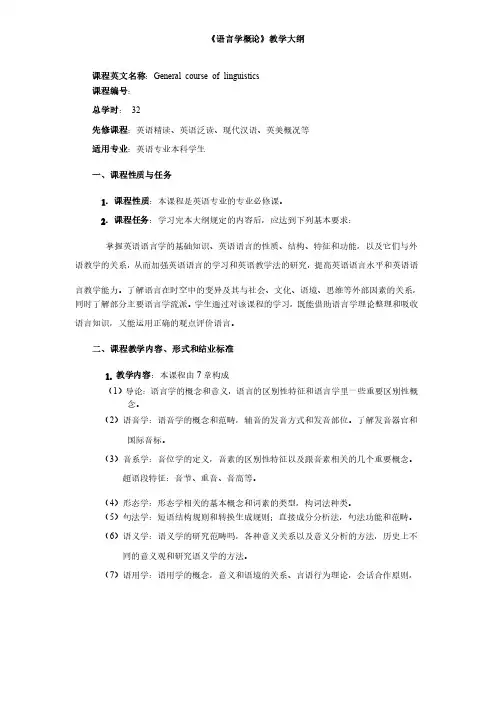
《语言学概论》教学大纲课程英文名称:General course of linguistics 课程编号:总学时:32 先修课程:英语精读、英语泛读、现代汉语、英美概况等适用专业:英语专业本科学生一、课程性质与任务1.课程性质:本课程是英语专业的专业必修课。
2.课程任务:学习完本大纲规定的内容后,应达到下列基本要求:掌握英语语言学的基础知识、英语语言的性质、结构、特征和功能,以及它们与外语教学的关系,从而加强英语语言的学习和英语教学法的研究,提高英语语言水平和英语语言教学能力。
了解语言在时空中的变异及其与社会、文化、语境、思维等外部因素的关系,同时了解部分主要语言学流派。
学生通过对该课程的学习,既能借助语言学理论整理和吸收语言知识,又能运用正确的观点评价语言。
二、课程教学内容、形式和结业标准1. 教学内容:本课程由7章构成(1)导论:导论:语言学的概念和意义,语言学的概念和意义,语言学的概念和意义,语言的区别性特征和语言学里一些重要区别性概语言的区别性特征和语言学里一些重要区别性概念。
(2)语音学:语音学的概念和范畴,辅音的发音方式和发音部位。
了解发音器官和国际音标。
(3)音系学:音位学的定义,音素的区别性特征以及跟音素相关的几个重要概念。
超语段特征:音节、重音、音高等。
(4)形态学:形态学相关的基本概念和词素的类型,构词法种类。
(5)句法学:短语结构规则和转换生成规则;直接成分分析法,句法功能和范畴。
(6)语义学:语义学的研究范畴吗,各种意义关系以及意义分析的方法,历史上不同的意义观和研究语义学的方法。
(7)语用学:语用学的概念,意义和语境的关系、言语行为理论,会话合作原则,了解会话含义,礼貌原则。
了解会话含义,礼貌原则。
(8)语言和文化:)语言和文化: 语言、文化和社会的关系,语言的变体,Sapir -Whorf 假说。
2. 教学形式:本课程采用课堂讲授与课后作业相结合的方式进行。
:本课程采用课堂讲授与课后作业相结合的方式进行。
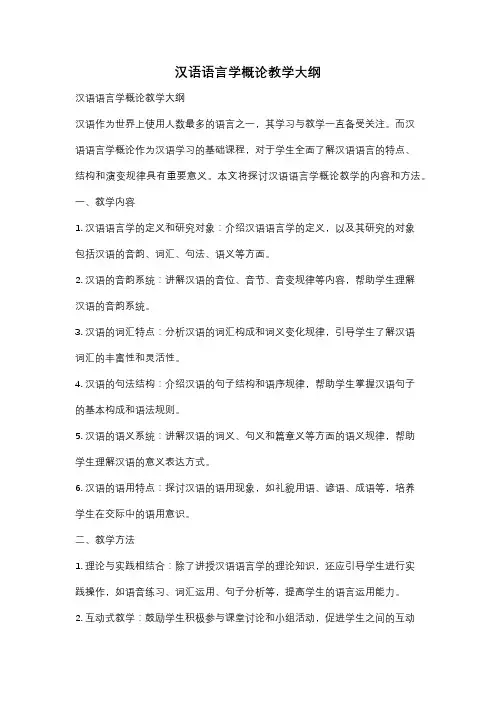
汉语语言学概论教学大纲汉语语言学概论教学大纲汉语作为世界上使用人数最多的语言之一,其学习与教学一直备受关注。
而汉语语言学概论作为汉语学习的基础课程,对于学生全面了解汉语语言的特点、结构和演变规律具有重要意义。
本文将探讨汉语语言学概论教学的内容和方法。
一、教学内容1. 汉语语言学的定义和研究对象:介绍汉语语言学的定义,以及其研究的对象包括汉语的音韵、词汇、句法、语义等方面。
2. 汉语的音韵系统:讲解汉语的音位、音节、音变规律等内容,帮助学生理解汉语的音韵系统。
3. 汉语的词汇特点:分析汉语的词汇构成和词义变化规律,引导学生了解汉语词汇的丰富性和灵活性。
4. 汉语的句法结构:介绍汉语的句子结构和语序规律,帮助学生掌握汉语句子的基本构成和语法规则。
5. 汉语的语义系统:讲解汉语的词义、句义和篇章义等方面的语义规律,帮助学生理解汉语的意义表达方式。
6. 汉语的语用特点:探讨汉语的语用现象,如礼貌用语、谚语、成语等,培养学生在交际中的语用意识。
二、教学方法1. 理论与实践相结合:除了讲授汉语语言学的理论知识,还应引导学生进行实践操作,如语音练习、词汇运用、句子分析等,提高学生的语言运用能力。
2. 互动式教学:鼓励学生积极参与课堂讨论和小组活动,促进学生之间的互动和合作,提高学生的学习效果。
3. 多媒体辅助教学:利用多媒体技术,展示汉语语言学的实例和案例,帮助学生更直观地理解和掌握知识。
4. 个性化教学:根据学生的语言水平和学习需求,灵活调整教学内容和方法,满足学生的个性化学习需求。
5. 评估与反馈:通过定期的作业、测验和口语表达等方式,对学生的学习情况进行评估和反馈,及时发现问题并进行指导。
三、教学目标1. 理论知识目标:使学生了解汉语语言学的基本理论知识,掌握汉语语言的基本特点和规律。
2. 实践能力目标:培养学生运用汉语语言学知识进行语音、词汇、句子和篇章的分析和运用能力。
3. 学习策略目标:引导学生形成有效的学习策略,提高自主学习和合作学习的能力。
语言学课程简介现代语言学课程是我院外语系英语专业本科阶段的一门专业限选课。
现代语言学研究始于20世纪初,其目的是要揭示人类语言的本质及其深层结构,对语言和语交际做出客观、科学的描述。
语言学作为一门社会科学,在国外是20世纪50年代以来发展最快、变化最大的学科之一。
在过去的五、六十年中,西方国家在语言学领域新说纷呈,建树颇多,其影响遍及哲学、心理学、社会学、教育学、人类学、考古学、通信技术、人工智能等学科。
语言学家对语言的研究从语言的物质外壳——语音开始,进而对它的结构和意义加以研究,从语言的抽象意义进而研究语言在交际中体现的具体意义,从而形成了语音学、音系学、形态学、句法学、语义学、语用学等一系列分支学科;语言学研究和社会学、心理学等人文学科的结合逐步形成了社会语言学和心理语言学这样的交叉学科;对语言理论在语言教学中的应用所进行的研究又导致了应用语言学的产生,语言和文化关系密切,对语言的研究不可避免地导致对文化以及对语言和文化两者相互关系的研究,等等。
因此语言学实际上是一个研究面十分宽广的领域,多年来世界各国语言学家的共同努力为这一领域带来了丰硕的成果,积累了大量文献。
在我们国家,虽然像王力、高铭恺等前辈从四、五十年代起就对西方的语言理论有所介绍,但由于种种原因,这门学科的意义直到10年动乱后才引起语言学界的足够重视,于是自1980年以来,国内各院校的英语专业相继开设了以英语讲授的各种语言学课程,最普遍的首推“普通语言学”和“语言学导论”。
我院外语系自1989起在英语专业本科四年级开设语言学课程,定为专业限选课。
对于主修语言的学生而言,对人类语言具备一定的理性认识,懂得一些语言学的知识和语言理论是完全有必要的,因此,我院外语系一直以来都十分重视语言学这门课程的建设,课程改革。
由于这门课程基本上是一门知识性的课程,需要学生记忆的内容比较多,所以强调在学习过程中要注意抓重点,着重掌握有关的基本概念和基本理论,在理解、消化的基础上记忆,不要死记硬背。
目前语言学这门课程也越来越受到学生的重视,因参加研究生考试的学生正在逐年增加。
我院外语系语言学这门课程所教授的对象是英语专业的学生,因此我们在讲解过程中基本全部采用英语的例子。
这些例子有助于学生们理解理论阐述,得到启发。
反过来,我们要求学生应能结合自己的语言实践提供更多的例子来解释有关理论,以达到理论与实践相结合,全面提高学生的外语能力,以期为学生本科毕业后继续深造或者从事英语教学奠定坚实的基础。
课堂讨论资料:I. Linguistic:1.What do you think about the importance of studying linguistics?2.What is language? What are the differences between human language and thesystem of animal communication?3.What are the differences between language and parole , competence andperformance?4.How, in your opinion, can we distinguish compounds from free phrases?5.How to define morphemes? How many kinds of morphemes can be classified?And what are the differences between free and bound morphemes, inflexional and derivational morphemes, root and stern?6.What is ICA ? What are its advantages and disadvantages?7.What is the semantic triangle?8.How, in your opinion, can we distinguish the complete homonyms from thepolysemic words?9.What is a conversational implication? How, in your opinion, can we infer whatthe speaker intends from what he says?10.How does a language undergo semantic change?II. Phonetics:1.What is the role of phonetics in modern science?2.What are the main branches of phonetics? What aspects of speech sounds do theystudy?3.What are the differences between phonetics and phonology?4.What are the main sources of human speech sounds?5.How, in your opinion, can we distinguish vowels from consonants ? Do you agreewith the air stream theory? Why?6.How are consonants and vowel classified?7.What are phone, phoneme and allophone? What are the difference?8.What are the differences of the function of pitch in English between that inChinese?9.What are suprasegmental phonemes? What are their functions in English?10.State some rules in phonology.《英语语言学》教学大纲一、教学目标主要以英语为例,全面地向学生介绍语言学的基础知识,从而使学生系统地了解语言(特别是英语)的语音、文字、词汇、语法、语义等主要方面,把握语言与语境、语言与文化、语言与文学、语言与教学等各种关系,并提高对语言的重要性的认识。
二、教学要求通过本课程的教学,要求学生基本掌握语言学及其分支学科的基本观点、理论和方法,不仅了解语音学、音系学、词法学、句法学、语义学、语用学等核心分支的内容,而且还要熟悉社会语言学、心理语言学及语言与文化、文字、计算机及外语教学的关系,形成对语言和语言学的系统认识。
三、教学内容Chapter 1 Invitations to LinguisticsTeaching aims:let the students have the general idea about language and linguistics.Teaching difficulties:design features of language ; some importantdistinctions in linguisticsTeaching proceduresnguageWhat is language?design features of language 语言的结构特征func tions of language2.linguisticsWhat is linguistics?2.2Main branches (scope) of linguisticsphonetics 语音学----the study of sounds used in linguistic communication.phonology 音系学(音位学)morphology 词法学syntax 句法学semantics 语义学pragmatics 语用学Impo rtant distinctions in linguisticsa.Descriptive vs. prescriptive “描写式”和“规定式”They represent two different types of linguistic study. If a linguistic study aims to describe and analyze the language people actually use, it is said to be descriptive; if the linguistic study aims to lay down rules for “correct and standard” behavior in using language, i. e. to tell people what they should say and what they should not say, it is said to be prescriptive.b.Synchronic vs. diachronic “共时”和“历时”The description of a language at some point of time in history isa synchronic study; the description of language as it changesthrough time is a diachronic study. A diachronic study is a historical study; it studies the historical development of language over a period of time.ngue & parole “语言”和“言语”The distinction was made by the Swiss linguist Saussure in the early 20th century. Langue refers to the abstract linguistic system shared by all members of a speech community, and parole refers to the realization of language in actual use.What linguists should do is to abstract langue from parole, i. e.to discover the regularities governing the actual use of language and make them the subjects of study of linguistics.petence and performance 语言能力和语言运用The distinction is discussed by the American linguist N. Chomsky in the late 1950’s.Competence----the ideal user’s knowledge of the rules of his language.Performance----the actual realization of this knowledge inlinguistic communication.e.Traditional grammar and modern linguisticsModern linguistics started with the publication of F. de Saussure’s book “Course in General Linguistics”in the early 20th century.So Saussure is often described as “father of modern linguistics”.The general approach traditionally formed to the study of language before that is roughly referred to as “traditional grammar.”They differ in several basic ways:Firstly, linguistics is descriptive while traditional grammar is prescriptive. A linguist is interested in what is said, not in what he thinks ought to be said. He describes language in all its aspects, but does not prescribe rules of “correctness”.Secondly, modern linguistics regards the spoken language as primary, not the written. Traditional grammarians, on the other hand, tend to emphasize, may be over-emphasize, the importance of the written word, partly because of its permanence.Then, modern linguistics differs from traditional grammar also in that it does not force languages into a Latin-based framework. To modern linguists ,it is unthinkable to judge one language by standards of another. They are trying to set up a universal framework, but that would be based on the features shared by most of the languages used by mankind.HomeworkQuestions and Exercises1,4,6,12Self-study guideRead “A New Concise Course On Linguistics For Students OfEnglish”Chapter 1 IntroductionChapter 2 Speech SoundsTeaching aims: let the students have the general idea about phonetics and phonology.Focal points: description of consonants and vowels; basic knowledge about phonologyTeaching difficulties: phoneme; allophone; minimal pair; complementary distributionTeaching procedure1. Phonetics1.1 Speech production and perception3 sub-branches of phonetics:Articulator phonetics----the study of the production of speech sounds Acoustic phonetics----the study of the physical properties of the soundsproduced in speechAuditory phonetics----the study of the perception of speech sounds 1.2 Speech organs (vocal organs)refers to the parts of the human body involved in the production of speech.The articulator apparatus of a human being contains 3 important areas: the pharynx (the throat), the oral cavity (the mouth), and the nasal cavity (the nose). The air- stream coming from the lungs is modified in various ways in these cavities, resulting in the production of various sounds.·The pharyngeal cavitySpeech sounds are produced with an air-stream as their source of energy. The air-stream comes from the lungs and then passes bronchi into trachea. At the top of the trachea is the larynx, the front of which is the Adam’s apple. This is the first place where sound modification might occur (lying across glottis), The larynx contains two pairs of structure; one of which is vocal folds (vocal cords). Vocal cords are two membranes, the vibration of which gives the quality of voicing to the sounds produced.●When the vocal cords are apart, the air can pass through easily andthe sound produced is said to be voiceless. Consonants [p, s, t ] are produced in this way●When they are close together, the airstreams causes them to vibrateand produces voiced sounds. e.g. [b, z, d]●When they are totally closed, no air can pass between them, thenproduce the glottal stop [?]The oral cavityThe oral cavity provides the greatest source of modification. The main places evolved are the tongue, the uvula, the soft palate, the teeth ridge, the teeth and the lips .of all these, the tongue is the most flexible. Various obstructions created within the oral cavity lead to the production of various sounder [p] [b]; [s] [z]; [k] [g]The nasal cavityThe nasal cavity is connected to the oral cavity at the back of the mouth .The soft part of the roof of the mouth, the velum, (soft palate) can be draw back to close the passage so that the air can only go through the mouth and produce vowels and most consonants. The passage can also be left open to allow air to exit through the nose and produce nasal consonants [m] [n] [g]1.3 phonetic transcriptiona method of writing down speech sounds in a systematic and consistent way.● I PA (International phonetic Alphabet)The idea was first proposed by the Danish grammarian Jespersen in 1886. The first version of IPA was published in August 1888.The latest version was devised in 1993 and corrected in 1996.With minor modifications, phoneticians and linguists now still use IPA. The basic principle of IPA is using a different letter for each distinguishable speech sound●Two ways to transcribe speech soundsBroad transcription: transcription with letter-symbols only.It’s normally used in dictionaries and teaching textbooks.Narrow transcription: transcription with letter-symbols together with the diacrtics. This is the transcription required and used by the phoneticians in their study of speech sounds.Diacritics: A set of symbols added to the letter-symbols to show that it has a sound value different from that of the same letter without the mark.1.4 English speech sounds● ClassificationThe English speech sounds can first of all be classified into vowels and consonants. The basic difference between them is that in the production of the former, the airstreams meets with no obstruction of any kind in the throat, the nose or the mouth, while in that of the latter it’s somehow obstructed.Semi-vowels ( semi-consonants) : the sounds produced with little obstruction.(also called glides or transition sounds) e.g. yet wet hot●Consonants (P44). 3 parameters to identify a consonant:①place of articulation: place in the mouth where obstruction occurs②manners of articulation: ways in which articulation can be accomplished③state of vocal cords: voiced VS. voiceless•Vowels (P45)the quality of vowels depend on position of tongue and the shape of lips.4.criteria (parameters) of vowel description①the position of highest part of the tinge :front, central, back②the height of tongue raising: high, middle, low③the shape of the lips (the degree of lip-rounding ) : rounded, unrounded④the length or tenseness of the vowel : tense vs. lax or long vs. shortpure vowels (monophthong)—vowels where the quality remains constant throughout the articulationvowel glides----vowels where there is an audible change of quality diphthongs—a single movement of the tongue is involvedtriphthongs—a double movement2.phonology2.1 phonology and phoneticsPhonetics and phonology are the two disciplines dealing with speech sounds. While both are related to the study of sounds, they differ in their approach and focus. Phonetic studies how speech sounds are made, transmitted and received. Phonology, on the other hand, is the study of sound systems of language. It’s concerned with the linguistic patterning of sounds, it aims to discover how speech sounds in a language form patterns and how these sounds are used to convey meaning in linguistic communication.e.g. tea too the sound [t] here is a nondistinctive sound (it donot cause meaning difference)phoneticians are concerned with how these two [t]’s differed in the way they are pronounced while phonologies are interested in the patterning of such sounds and rules that underlie such variants.Phonological knowledge permits a speaker to produce sounds which form meaningful utterance, to recognize a foreign accent, to make up new words.2.2 phonemes, allophones• phone: the speech sounds we use when speaking a language. It’s a phonetic unit or segment ( any linguistic unit which can be isolated from the rest).If we pronounce the words feel, leaf, top, stop, the speech sounds involved are [f][i:] [f][l][t][p][s][t], All these sounds are phones. Conventionally, phones are placed within square brackets “[ ]” (phonetic transcription)Phones do not necessarily distinguish meaning. Usually phones ofdifferent phonemes distinguish meaning.• phoneme: a n abstract unit that is of distinctive value. It’s a basic unit in phonological analysis. It is not any particular sound,.but rather it’s represented or realized by a certain phone in a certai n phonetic context.P honemes are placed in slashes “/ / ” (phonemic transcription) A phoneme is the smallest meaning-distinguishing unit.Neither the sound [p] in pit or the sound [b] in bit is a phoneme. They are phones; they are the phonetic realization of the phoneme /p/ and /b/. In actual speech, a phoneme is realized phonetically as a certain phone.•allophone: the different phones which can represent a phoneme in different phonetic environments are called the allophones of that phonemeFor example, [1] in English words “let, play, tell” are pronounced differently, and the substitution of [1] for [] would not make a different word, though native speakers may find pronunciation a bit strange so[1] and [f] are allophones of phoneme[1]One phoneme may have several allophones, but the choice of an allophone is rule-governed.•distinctive features: the features that a phoneme possesses, making it different from other phonemes, are its distinctive features. Distinctive features are language-specific. What doesn’t distinguish meaning in one language may probably do in another language. e.g. aspiration does not distinguish meaning in English, but it does in Chinese.e.g.“b a” (爸) “p a”(怕)In Chinese, these two sounds are distinguished by aspiration ,while in English they are distinguished by “voicing”2.3 The phoneme theoryThe phoneme is the basic unit in phonological analysis. •Complementary distribution and Minimal pairs.Phonetically similar sounds might be related in two ways. If they are two distinctive phoneme, they might form a contrast; e.g. /p/and /b/ in [pit] and [bit]; If they are allophones of the same phoneme, then they don’t distinguish meaning, but complement each other in distribution, i.e. they occur in different phonetic context.Strictly speaking, every sound is different from every other sounds. But in phonology some of the difference may be ignoredA basic way to determine the phonemes of a language is to see if substituting one sound for another result in a change of meaning. 1.Minimal pairs (最小对立体)When two different forms are identical in every way except for one sound segment which occurs in the same place in the strings, the two soundcombinations are said to form a minimal pair.three requirements for a minimal pair:•same number of segment•one phon etic difference in the same place•different meaninge.g. a minimal pair : lit-lip; phone-tone; pill-billa minimal set: beat, bit, bet, boot, but, bite2. Complementary distributionNot all speech sounds occur in the same environment, when the two sounds never occur in the same environment they are said to be in complementary distribution. For example, in English, [p=,ph] are two different sounds. They never occur in the same context, [p=] always occur after /s/ while [ph] always occur in other places.Not all phones in complementary distribution are considered to be allophones of the same phoneme. They must be phonetically similar and in complementary distribution.3.free variationA phone may sometimes has free variants. If two sounds occurring inthe same environment do not contrast, that is, the substitution of one for the other does not produce a different word form, but merely a different pronunciation of the same word, then the two sounds are in free variation.HomeworkQuestions and Exercises 1,3,5Self-study guideRead “Modern Linguistics” by He Zhao-xiongChapter 2 PhonologyChapter 3 LexiconTeaching aims: let the students have a brief knowledge about morphemes and the basic word-formation methodsFocal points:definition and classification of morphemes; major word-formation methodsTeaching procedure1.Wordlexicon, lexeme, vocabularylexiconIn its most general sense, lexicon is synonymous with vocabulary. In its technical sense, it deals with the analysis and creation of words. • vocabularyIt usually refers to all the words or lexical items a person has acquired about technical or un-technical things. It is also used to mean world list or glossary.• lexeme: p 77Word• Definition of “word”A unit of expression that has universal intuitive recognition by native-speakers, whether it is expressed in spoken or written form. • Three senses of “word”a.a physical definable unit: a cluster of sound segments or lettersbetween two pause or blankb.the common factor underlying a set of formsc.a grammatical unite.g. It is kind of you ,Miss Hou.Every word plays a grammatical part in the sentence.• Classification of worda.Variable and invariable wordsb.Grammatical words vs. lexical wordsc.Closed-class words vs. open-class words2.MorphemeMorphology and morphemeTypes of morphemes• Free morpheme: those which may constitute words by themselves • Bound morpheme: those which can not be used by themselves, but must be combined with other morphemes to form wordsInflectional morpheme: manifest various grammatical relations or grammatical categories such as number, tense, degree and case.E.g.walks, walking, walked ; John’s; children; biggest Derivational morpheme: prefix: change meaning dis-; un-; mis- suffix: change part of speech -ly; -ness;-tionWord formationCompounding: F+Fblackboard godfather baby-sitDerivation: B+F or F+BBlending (join two parts of words together): smog; motel; brunch ClippingShortening or abbreviationInitialism: VOA BBC WTOAcronym: UNCESO APEC SARBack-formationBorrowingHomeworkQuestions and Exercises 1,2,3,5Self-study guideFurther readingAdams,V. 1973. An Introduction to Modern English Word-Formation.Dai Wei-dong, 2002 A New Concise Course On Linguistics For Students OfEnglishChapter 3 MorphologyChapter 4 SyntaxTeaching aims: enable the students to understand and describe the internal structures of sentencesFocal points: different treatment of sentence structure by different linguistic schoolsTeaching difficulties: IC analysis, deep structure, surface structure, tree diagramTeaching procedureSyntax is the study of how words combine to form sentences and the rules which govern the formation of sentences. Since sentence is usually regarded as the largest grammatical unit of a language, syntax has long been the center of grammatical study. In this chapter, we introduce some of the representative approaches to syntax.1. The traditional approachLexical categories: words are organized into groups of lexical categories, commonly knows as part of speech e.g.: n, v, adj, determiner etc. Syntactic categories: words and phrases are organized according to the syntacticcategories they belong to. Syntactic categories usually refers to a word or a phrase that performs a particular grammatical functions.e.g. subject, predicate, object etc.2.The structural approachStarted by the Swiss linguist Saussure.Try to describe each language as a self-contained structural system.The structural approach regards linguistic units as interrelated with each other in a structure or a system..2.1 Syntagmatic and paradigmatic relations•Syntagmatic relations 组合关系 horizontal relation chain relationa relation between one item and others in a sequence (the sequential arrangement of words in a language.)It is also called horizontal relation or chain relationThere are syntactic and semantic conditions the words in a syntagmatic relation must meet.•Paradigmatic relation 纵聚合关系vertical relation \choice relation Relation holding between elements replaceable with each other at a particular place in a structure.It is also called vertical relation or choice relationE.g.: The smiles.manboyHe went there .yesterdaylast weekafter he finished the examAll these words are said to be in a paradigmatic relation. They can substitute for each other without violating syntactic rules, because they share the same syntactic features.聚合关系和组合关系一起共同确立一个语言单位在语言系统中的特征。